(Disclosure: Some of the links below may be affiliate links) I have recently read a recommendation to invest only once a quarter instead of more frequently. I think investing every quarter is bad advice and I want to explain why in this article. As I have a lot of data on my hands, I figured the best way to provide it would be to run simulations. And so I did! In this article, I will show you why you should invest every month and not less frequently than that. Investing Every Month Every month, as soon as I am done paying my bills for the month, I transfer the money left on my broker account. And as soon as the money reaches my broker account, I invest it in the stock market. I only invest in a single ETF every month. This strategy is straightforward, but it works quite well. And
Topics:
Mr. The Poor Swiss considers the following as important: Investing
This could be interesting, too:
Lance Roberts writes CAPE-5: A Different Measure Of Valuation
Lance Roberts writes CAPE-5: A Different Measure Of Valuation
Lance Roberts writes Estimates By Analysts Have Gone Parabolic
Lance Roberts writes The Impact Of Tariffs Is Not As Bearish As Predicted
(Disclosure: Some of the links below may be affiliate links)

I have recently read a recommendation to invest only once a quarter instead of more frequently. I think investing every quarter is bad advice and I want to explain why in this article.
As I have a lot of data on my hands, I figured the best way to provide it would be to run simulations. And so I did!
In this article, I will show you why you should invest every month and not less frequently than that.
Investing Every Month
Every month, as soon as I am done paying my bills for the month, I transfer the money left on my broker account. And as soon as the money reaches my broker account, I invest it in the stock market. I only invest in a single ETF every month.
This strategy is straightforward, but it works quite well. And contrary to what people believe, it takes me very little time. It does not take me more than 10 minutes per month.
It is why I have always recommended my readers to invest every month and not less frequently.
But there are other advantages to this than just being simple and easy. By investing the money when you have, you are always invested in the market. You do not have to wait several months for this money to be invested. It means that your money does not wait with a zero interest rate in your bank account. Instead, it can get returns from the stock market earlier. And it is much better to build a habit when you build it more frequently.
For me, it is clear that people are going to lose money when they invest every quarter instead of investing every month. But until now, I never did the simulations. It is time to change that!
Let’s find out exactly how much quarterly investors are losing compared to monthly investors!
Differences in investing frequencies
The best way to know whether investing every month or every quarter makes any difference is by running simulations! And it turns out, I have a wealth of historical data available to me!
I have collected a lot of data for my simulations of the Trinity Study. I have the monthly returns of the U.S. stock market from 1871 to 2019. So, I can use this data to see the difference between different investing frequencies.
Let’s start with the average portfolio after 10 years of investing. The investor is investing 1000 USD per month. If the investing frequency is 2 months, the investor will wait 2 months and invest 2000 USD. And if the frequency is 6 months, the investor will wait 6 months and invest 6000 USD. At the end of the simulation period, I will take the average portfolio value into account.
So, let’s start to see the difference after 10 years of investing:
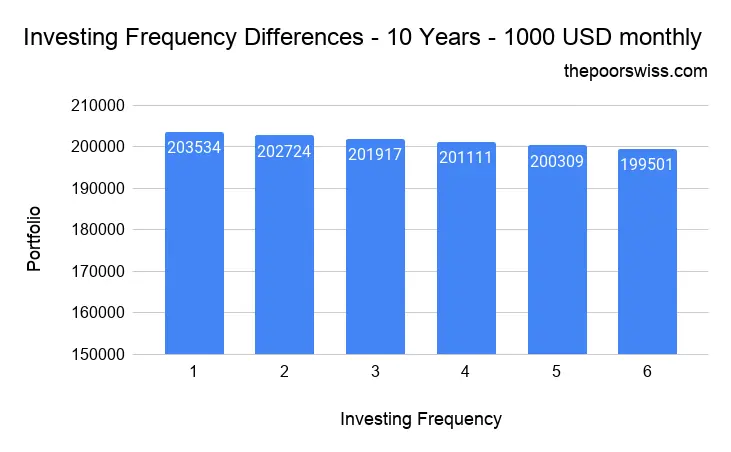
After 10 years, if you invest once per quarter, you already lost 1617 USD. And if you invest even less frequently every 6 months, you have lost 4033 USD! And it is only by investing 1000 USD every month.
Let’s see what happens after 20 years.
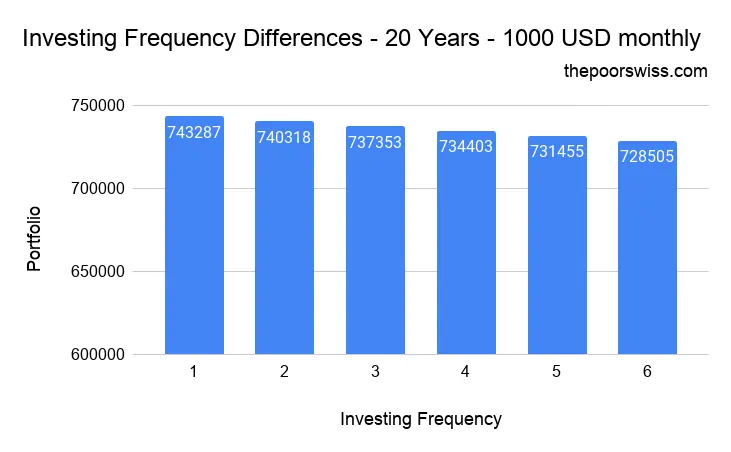
After 20 years, the quarterly investor lost 5934 USD compared to the monthly investor. For most people, this is more than one month of retirement. So, the quarterly investor wasted one month already!
What if we invest more?
Until now, our scenarios only invested 1000 USD per month. Let’s see what happens if our investors are investing 2000 USD every month.
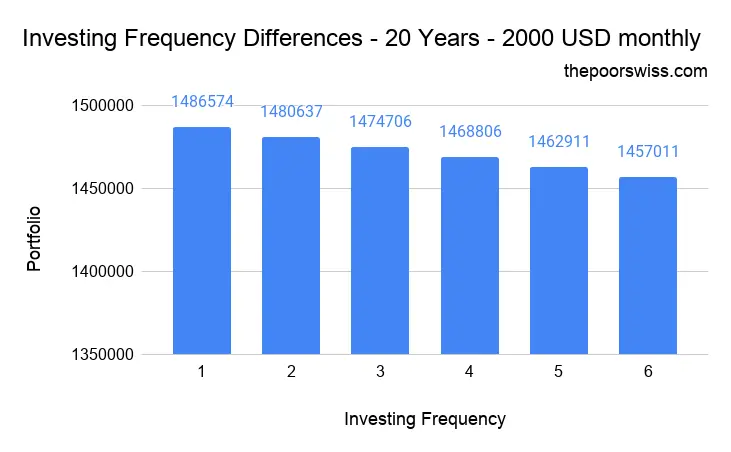
When we invest more every month, the differences are higher between each investing frequency. By investing every quarter instead of every month, our investor is losing 11868 USD! This is at least 2 months of retirement wasted!
Finally, let’s increase that to 5000 USD per month.
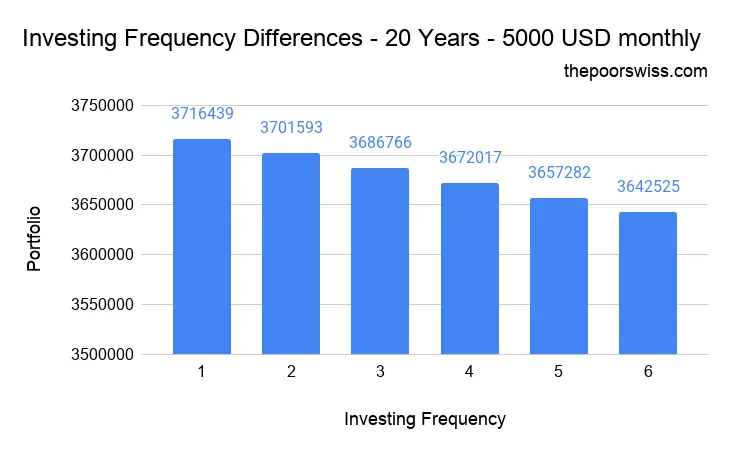
Over 20 years, by investing quarterly instead of every month, our investor has lost 29673 USD! For most people, this is half a year of retirement. I am pretty sure this is not worth the few minutes saved each quarter!
What about the worst case?
Until now, we have seen the average portfolio value and, thus, the average loss of each investing frequency compared to investing every month. But we can also take a look at the worst case. By the worst case, I mean the worst possible loss an investing frequency different from every month could be.
Let’s see the worst possible loss after 20 years and 1000 USD monthly investing.
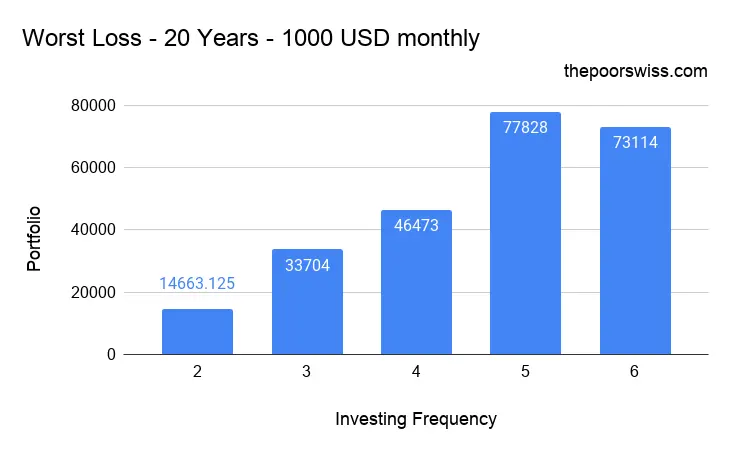
By investing quarterly, the worst loss you could have is 33704 USD. With only investing 1000 USD per month, this is already a significant loss.
Of course, we have to look at the best case. There are some years when it is better to invest less frequently.
So, here are the best possible gains after 20 years with 1000 USD per month.
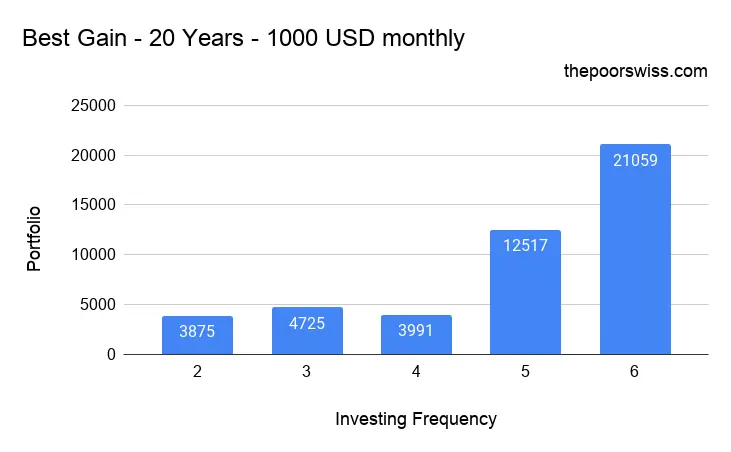
By investing quarterly, the best case would be to gain 4725 USD after 20 years.
So, we can summarize this scenario. After 20 years and 1000 USD invested per month, by investing quarterly:
- On average, you would lose 5’934 USD
- In the worst case, you would lose 33’704 USD
- In the best case, you would gain 4’725 USD
I do not know about you, but seeing that we lose money on average and that the worst is seven times more significant than the best case, I can easily say that investing every month has significant advantages over investing each quarter. And the same is true of any less frequent investing strategy.
What about the Swiss Stock Market?
Until now, we have talked bout the U.S. Stock market. We can run the same simulations on the Swiss Stocks Market. I also have the data for the Swiss Stock Market from 1924 to 2019.
So, let’s run the same simulation for 20 years with 1000 CHF monthly investing in the Swiss Stock market.
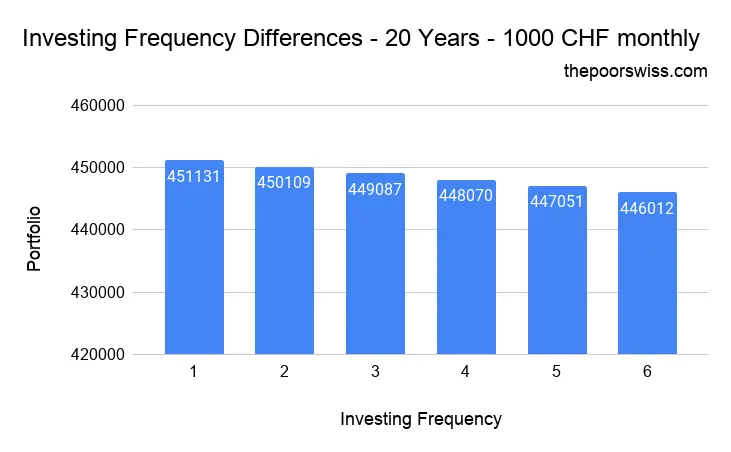
On average, an investor on the Swiss Stock Market would lose 2044 CHF after 20 years. It is less important than for the U.S. Stock Market. The reason is that the Swiss stock market returns less than the U.S. Stock Market.
Let’s look at the worst case for the same scenario:
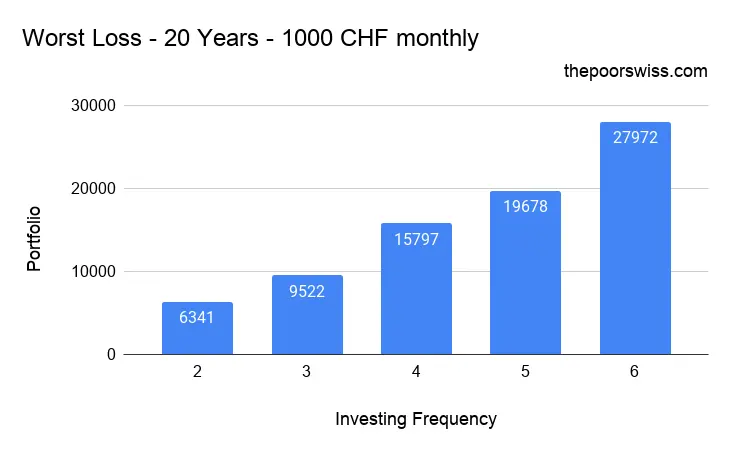
The worst loss for investing quarterly would be 9522 CHF after 20 years. Again, this is less significant than for the U.S. But it remains a significant amount of money.
Finally, let’s look at the best case for the same scenario:
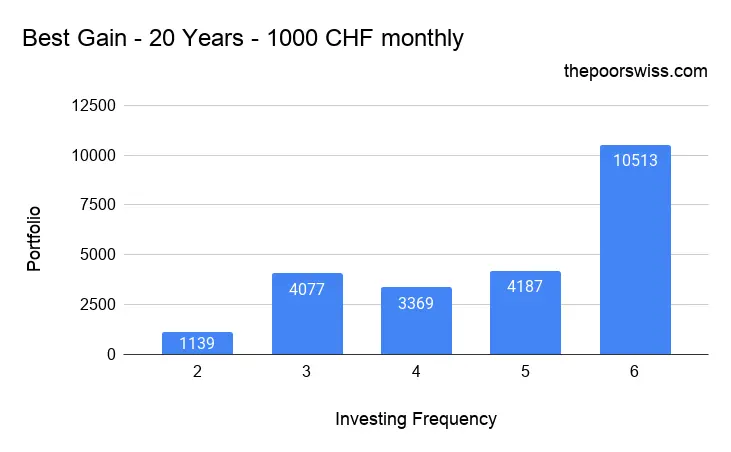
So, the best gain would be 4077 CHF after 20 years.
We now have all the numbers to summarize the differences in investing quarterly in the Swiss Stock Market compared to investing every month, after 20 years:
- On average, you would lose 2’044 USD
- In the worst case, you would lose 9’522 CHF
- In the best case, you would gain 4’077 CHF
Again, on average, we lose money, and the worst case is more significant than the best case, so investing every month in the Swiss Stock Market is better than investing quarterly.
What about fees?
One of the points the quarterly investors are making is that they want to reduce fees. So, let’s see the difference in fees between different investing frequencies.
I already have a calculator for DEGIRO and Interactive Brokers so that I can use it as well. For this comparison, I will only use the DEGIRO Basic, and Interactive Brokers Tiered accounts since they are the cheapest. I will take the fees for ETFs into accounts for both markets (let’s ignore the fact that DEGIRO cut us out of the U.S. ETF market). And the last recommendation I have seen about quarterly investing was using Interactive Brokers, the cheapest broker available to Swiss Investors.
Let’s start with the U.S. Stock Market. We can look at the fees for 20 years with these two brokers and 1000 monthly investing:
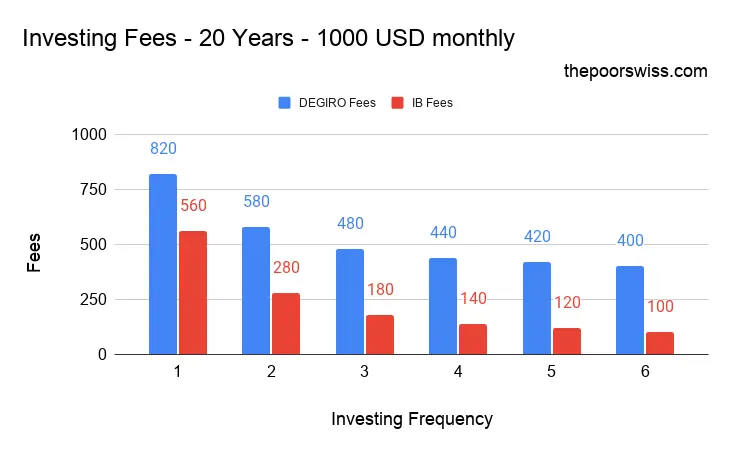
There are several interesting facts with these results. First, we can confirm that investing less frequently results in lower fees. But this is logical since most brokers have some flat fees. What is also interesting is that there is almost no reduction after the fourth month. So reducing the frequency to anything less frequent than quarterly does not make sense.
By investing in the U.S. stock market quarterly instead of every month, an investor can save 340 CHF over 20 years with DEGIRO and 380 CHF with Interactive Brokers. These savings represent less than 20 CHF per year.
Let’s put that in perspective with the average loss of 5’934 USD after 20 years. To save a maximum of 380 CHF, you are sacrificing 5934 USD! I hope you realize that it does not make sense. And keep in mind that this is only for 1000 USD invested per month. The difference is even larger for more investing!
But maybe the Swiss Stock market is different? Let’s see the fees for 20 years of investing in the Swiss Stock Market.
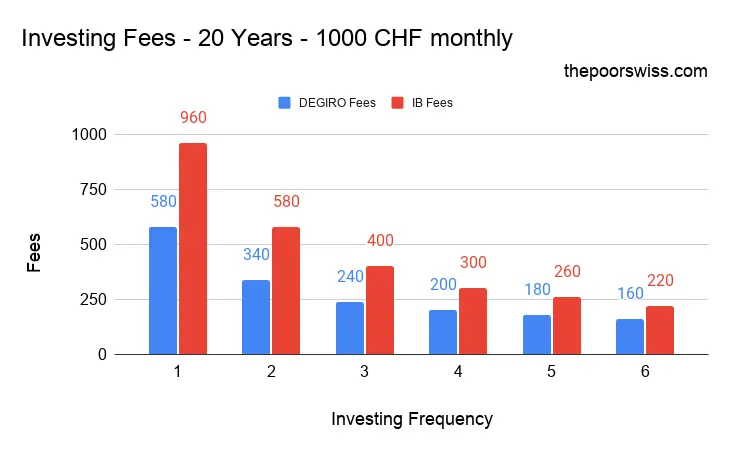
For the Swiss Stock Market, we can see that DEGIRO is cheaper than Interactive Brokers. This does not make DEGIRO cheaper for a Swiss investor since we invest more in the U.S. than in Switzerland. But it is still interesting to note.
By investing in the U.S. stock market quarterly instead of every month, an investor can save 340 CHF over 20 years with DEGIRO and 560 CHF with Interactive Brokers. These savings represent less than 30 CHF per year. But we can see that we can save a little more on the Swiss Stock market than in the U.S. Stock Market.
Once again, let’s put that in perspective with the average loss of 2’044 CHF after 20 years. To save a maximum of 560 CHF, you are sacrificing 2044 CHF! Once again, it does not make sense to invest quarterly!
Conclusion
As you can see, you will not save any money by not investing every month. Investing every month is the most efficient strategy!
Some people will tell you to invest every quarter instead of every month. But you are going to lose money by investing quarterly. Indeed, by letting your money in a bank account, you are losing on the returns from the stock market. And the broker fees you are saving are not insignificant compared to the loss.
Some people will argue that you will save some time by investing quarterly. But honestly, if you are not willing to invest a quarter of an hour per month to buy an ETF (much less than that generally), you are not motivated enough! It is entirely worth your time (and your money) to spend a few hours per year to invest in the stock market properly.
How often do you invest?
